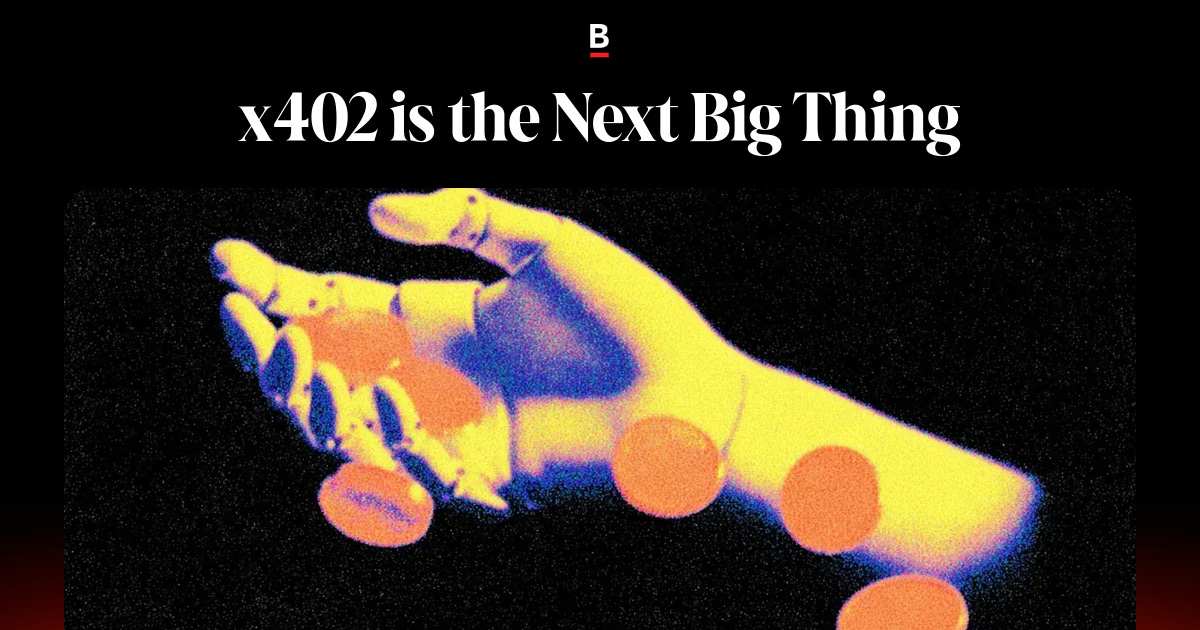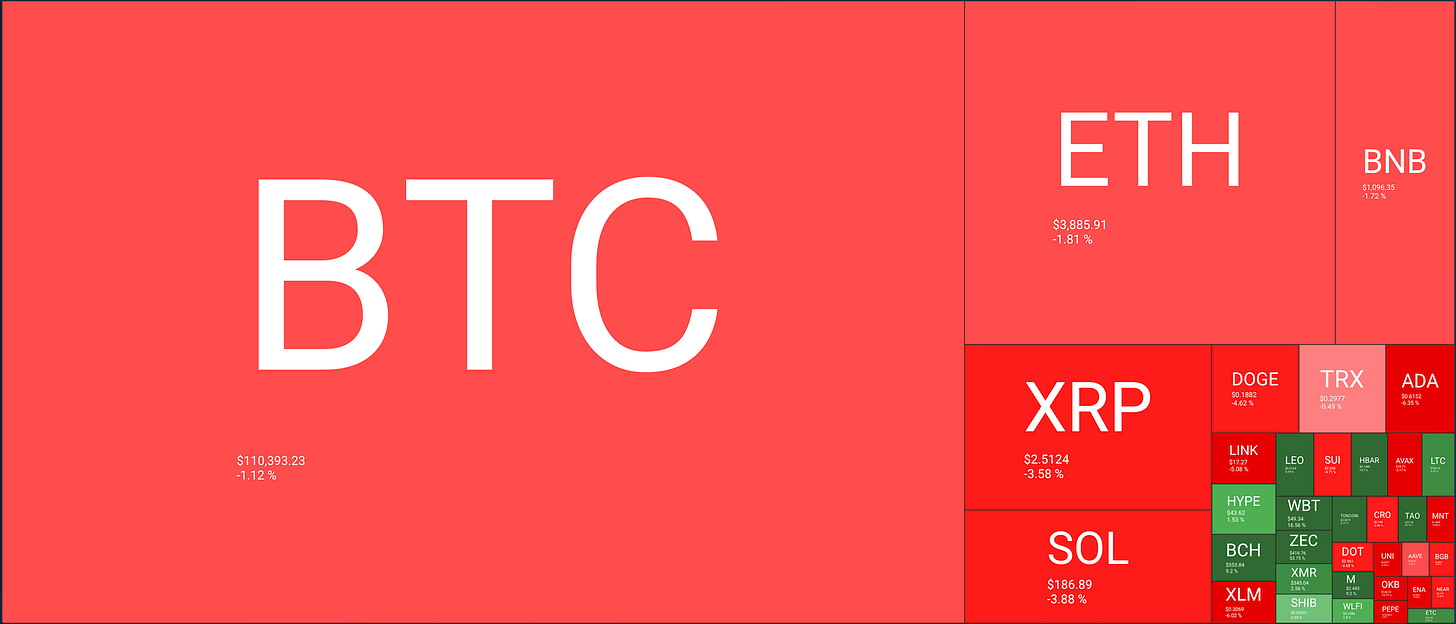Weekly Journal: How x402 Makes Native Internet Commerce Possible
[6 min read] Your weekend guide to getting ahead on the digital frontier. Stablecoins, sub-second blocktimes, and AI-driven agents has revived HTTP 402 as x402 — a mechanism for per-request payments.
Welcome to this week’s Weekly Journal 📔, your guide to the latest news & innovation in emerging technology, digital assets, and our exciting path to the Metaverse. This is week 151 of the 520 weeks of newsletters I have committed to, a decade of documenting our physical and digital lives converge. New subscribers are encouraged to check out the history & purpose of this newsletter as well as the archive.
- Ryan
🌐 Digital Assets Market Update
To me, the Metaverse is the convergence of physical & virtual lives. As we work, play and socialise in virtual worlds, we need virtual currencies & assets. These have now reached mainstream finance as a defined asset class:
🔥🗺️Heat map shows the 7 day change in price (red down, green up) and block size is market cap.
🎭 Crypto Fear and Greed Index is an insight into the underlying psychological forces that drive the market’s volatility. Sentiment reveals itself across various channels—from social media activity to Google search trends—and when analysed alongside market data, these signals provide meaningful insight into the prevailing investment climate. The Fear & Greed Index aggregates these inputs, assigning weighted value to each, and distils them into a single, unified score.
🗞️ Metaverse news from this week:
17 years Later, Bitcoin’s White Paper Still Shapes the Digital Future — and the Metaverse Economy
Seventeen years after its release, Satoshi Nakamoto’s Bitcoin white paper is being re-examined not just as a crypto origin story, but as a blueprint for a more reliable digital financial system. Writing for CoinDesk, Bobby Shell argues that the paper’s true legacy lies in its architecture for trustless value transfer, a model that could anchor everything from instant global payments to metaverse economies.
The white paper diagnosed deep flaws in legacy payment systems still visible today — reliance on intermediaries, settlement delays, and systemic fragility. Bitcoin’s innovation was to replace institutional trust with cryptographic verification and open consensus, creating a digital settlement layer that could scale independently of banks.
This design, Shell notes, is not static but layered. The Bitcoin base chain provides finality and neutrality, while higher-speed layers like the Lightning Network enable real-time, low-cost transactions. That separation of settlement and experience mirrors how metaverse platforms will need to operate: a secure base layer for ownership and identity, with fluid layers for social and economic interaction.
From a metaverse perspective, Bitcoin’s white paper remains one of the foundational texts of digital sovereignty. It envisioned a world where individuals, not institutions, control the rails of value — a principle now extending to virtual assets, digital identities, and tokenized property.
As Shell concludes, the white paper wasn’t the end of Bitcoin’s story, but the beginning of a new, trust-minimized digital order—one that continues to evolve toward a transparent, decentralised economy capable of powering both global commerce and the metaverse.
🌐 5 Metaverse Takeaways: Bitcoin’s White Paper Was the First Metaverse Infrastructure Blueprint
1. Verification replaces trust. The metaverse will rely on provable ownership—for assets, identity, and reputation. Bitcoin’s trustless verification model laid the foundation for that architecture, proving that digital value can exist without intermediaries.
2. Decentralisation as stability. Where banks once acted as settlement hubs, future metaverse economies will anchor on decentralised ledgers—ensuring global, censorship-resistant value exchange between avatars, businesses, and autonomous agents.
3. Layered design mirrors spatial computing. Bitcoin’s base layer secures value, while upper layers enable speed and interactivity. The same model is emerging across metaverse infrastructure: base-chain finality with high-speed experience layers for gaming, commerce, and AI.
4. Predictable rules enable creative freedom. By embedding logic at the protocol level, Bitcoin proved that financial systems can be both rule-bound and open. That predictability now underpins the confidence required for building persistent digital worlds.
5. From money to meaning. What began as a payment protocol has become a philosophical scaffold for a user-owned internet. The metaverse isn’t just a 3D space—it’s the continuation of Bitcoin’s mission: a verifiable, borderless economy built on code, not trust.
📖 Read of the week: The Resurrection of HTTP 402 - How x402 Makes Native Internet Commerce Possible
🗞 Via Bankless | October 2025
In the early 1990s, as the web’s architects were sketching the protocols that would shape the internet, they reserved an unused HTTP status code: 402 — Payment Required. It was meant for a future in which every digital request — every article read, API call made, or data packet consumed — could carry a tiny native payment.
But the future didn’t arrive. Online payments were clunky, banks weren’t programmable, and credit cards were far too expensive for micro-transactions. So 402 sat dormant — a ghost in the protocol stack — while the web evolved around ad-based monetisation, surveillance, and subscriptions.
Now, in 2025, the ghost has awakened. The rise of stablecoins, sub-second blocktimes, and AI-driven agents has revived HTTP 402 as x402 — a mechanism for per-request payments that reimagines the web’s economic fabric.
⚙️ What’s new with x402
Bankless’ latest feature traces how Coinbase’s AI-centric payment rails are quietly powering early x402 adoption. Instead of shoe-horning banking into the web, x402 lets any URL become a price-tagged resource.
“Resources” can be anything of value — a weather dataset, a model inference, an API response, a digital asset, or even a compute instruction. Each request can carry a machine-readable micro-payment, settled instantly in stablecoins (e.g. USDC on Base), with no identity exchange and no chargebacks.
For humans, this could mean paying $0.05 to skip a queue or $1 to unlock an article. For AI agents, it means something far bigger — autonomous machine-to-machine commerce. Agents can now discover, price, and combine resources across the open web, paying as they go.
As the article puts it:
“This is the ultimate money lego system — the missing component of the internet’s design that allows digital value to flow as freely as data.”
🌐 Why it matters
The implications stretch beyond payments:
x402 enables trust-minimised micro-transactions at internet scale — the foundation for a resource-based web economy.
It dissolves the need for personal identity in commerce, aligning with the privacy-preserving ethos of Web 3.
It provides the economic substrate for AI agents and metaverse entities to transact autonomously — paying for compute, storage, or virtual services as they operate.
In effect, x402 revives the original dream of the web: a self-monetising digital commons that rewards creators, sustains infrastructure, and frees users from the advertising trap.
🪙 Macro context: From Debasement to Native Money
The timing couldn’t be better. As Bankless’ companion essay “Betting on Debasement” notes, the world is leaving behind trust in fiat-backed systems — turning instead to hard, programmable money. Gold and Bitcoin are emerging once again as neutral reserve assets, while stablecoins provide the transactional bridge.
x402 completes the circuit — linking the protocol layer of the internet with the monetary layer of crypto. It’s not just payments for humans, but the birth of a new machine-economy where agents, DAOs, and metaverse services transact seamlessly.
Takeaway:
After thirty years of silence, HTTP 402 has finally found its moment.
x402 may become the invisible protocol that lets the metaverse, AI agents, and decentralised networks pay their own way — per request, per compute, per action — ushering in an internet where every interaction is also an exchange of value.
🔗 Read the full piece on Bankless
🎥 Watch of the week:
Marques Brownlee offers a critical look at a new humanoid robot, Neo. The video analyzes Neo’s advertised capabilities versus its current functionality, highlighting a crucial difference. Explore the debate around pre-orders and the promises of AI in consumer tech.
AI Spotlight 🎨🤖🎵✍🏼: Māori Leaders Chart a Global Path for Ethical AI
In the Metaverse, AI will be critical for creating intelligent virtual environments and avatars that can understand and respond to users with human-like cognition and natural interactions.
In a landmark move for Indigenous data sovereignty, Te Kāhui Raraunga, the data arm of the Iwi Chairs Forum, has unveiled a new AI safeguards framework designed to protect Māori data and ensure artificial intelligence systems reflect cultural values, transparency, and equity.
Lead technician Kirikowhai Mikaere (Tūhourangi, Ngāti Whakaue) said the goal isn’t to restrict innovation, but to distinguish New Zealand as a world leader in ethical AI. “It’s not about restriction, it’s about distinction,” she explained — envisioning a future where Aotearoa’s AI systems uplift Māori rather than amplify colonial bias.
The framework calls for:
Regular bias monitoring and clear accountability across public sector AI use.
Transparency, including a public register of government algorithms.
Free, prior, and informed consent when using Māori data or likenesses.
An independent oversight body to uphold fairness and cultural safety.
Chairperson Rāhui Papa reinforced that Māori data is a taonga — a living treasure — that must be governed through tikanga (customs) and mana (authority). “Ethical AI starts with honouring te Tiriti, embedding Māori leadership, and holding agencies accountable,” he said.
By aligning with international models like Denmark’s deepfake protections, Te Kāhui Raraunga’s framework positions Aotearoa to set a new global benchmark for Indigenous-led AI governance — one rooted in care, respect, and partnership.
In an era when AI risks deepening digital inequities, Māori leaders are offering something far rarer: a blueprint for human-centred, culturally grounded intelligence — proof that technology can evolve without losing its heart.
That’s all for this week! If you have any organisations in mind that could benefit from keynotes about emerging technology, be sure to reach out. Public speaking is one of many services I offer.



